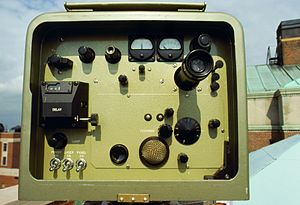Geodimeter: Difference between revisions
Content deleted Content added
Bri.public (talk | contribs) →Further reading: Electronic Surveying and Mapping, Laurila 1960 |
Bri.public (talk | contribs) →Further reading: tweak citation |
||
| Line 22: | Line 22: | ||
*{{citation|last=Rimington|first=George Robert Lindsay |year=1956|title=Introduction to the Geodimeter|journal=[[Cartography (journal)|Cartography]]|volume=1|number=3|date=March 1956|pp=120-124|url=https://webarchive.nla.gov.au/awa/20150629231721/http://pandora.nla.gov.au/pan/166632/20180227-0206/www.xnatmap.org/adnm/docs/2013/aganasm/geod+intro.html|via=[[Pandora Archive]]}} |
*{{citation|last=Rimington|first=George Robert Lindsay |year=1956|title=Introduction to the Geodimeter|journal=[[Cartography (journal)|Cartography]]|volume=1|number=3|date=March 1956|pp=120-124|url=https://webarchive.nla.gov.au/awa/20150629231721/http://pandora.nla.gov.au/pan/166632/20180227-0206/www.xnatmap.org/adnm/docs/2013/aganasm/geod+intro.html|via=[[Pandora Archive]]}} |
||
*{{citation|title=The Geodimeter and Tellurometer|first=Austin C. |last=Poling|publisher=American Society of Civil Engineers|doi=10.1061/JSUEAX.0000024|journal=Proceedings of the American Society of Civil Engineers: Journal of the Surveying and Mapping Division|volume=84|issue=1|date=April 1958}} |
*{{citation|title=The Geodimeter and Tellurometer|first=Austin C. |last=Poling|publisher=American Society of Civil Engineers|doi=10.1061/JSUEAX.0000024|journal=Proceedings of the American Society of Civil Engineers: Journal of the Surveying and Mapping Division|volume=84|issue=1|date=April 1958}} |
||
*{{citation|chapter=Geodimeter|pages=194-203|title=Electronic Surveying and Mapping: Part 1, Fundamentals of Electronic Surveying|first=Simo|last=Laurila|year=1960|publisher=Institute of Geodesy, Photogrammetry and Cartography, The Ohio State University|OCLC=58011617|url=https://hdl.handle.net/2027/uiug.30112007333120}} |
*{{citation|chapter=Geodimeter|pages=194-203|title=Electronic Surveying and Mapping: Part 1, Fundamentals of Electronic Surveying|first=Simo|last=Laurila|year=1960|publisher=Institute of Geodesy, Photogrammetry and Cartography, The Ohio State University|OCLC=58011617|url=https://hdl.handle.net/2027/uiug.30112007333120|via=Haithi Trust |accessdate=May 6, 2021}} |
||
==External links== |
==External links== |
||
Revision as of 18:00, 6 May 2021

The Geodimeter (acronym of geodetic distance meter) was the first optical electronic distance meter surveying instrument.[1][2] It was originally developed for measuring the speed of light.[3][4] It was invented in the 1940s by Erik Osten Bergstrand and commercialized in 1953 by the AGA (Aktiebolaget Gasaccumulator) company of Sweden.[5] It was used in the Transcontinental Traverse.
Electronic mechanism
The mechanism uses a Kerr cell in an optical train that chops a collimated light beam under the control of a precision electronic oscillator in the megahertz range.[6] It is similar in principle to earlier mechanical choppers in Fizeau–Foucault apparatus that used a toothed wheel or a rotating mirror.[7]
See also
References
- ^ Rüeger, J.M. (2012). Electronic Distance Measurement: An Introduction. Springer Berlin Heidelberg. p. 15. ISBN 978-3-642-80233-1. Retrieved 2020-09-24.
- ^ Bergstrand, Erik (2008). "Distance measuring by means of modulated light". Bulletin Géodésique. 24 (1): 243–249. doi:10.1007/BF02526937. ISSN 0007-4632. S2CID 121587208.
- ^ Froome, K.D.; Essen, L. (1969). The Velocity of Light and Radio Waves. Academic Press. Retrieved 2020-09-24.
- ^ Bergstrand, Erik (1950). "Velocity of Light". Nature. 165 (4193). Springer Science and Business Media LLC: 405. doi:10.1038/165405a0. ISSN 0028-0836. S2CID 4281189.
- ^ "AGA Geodimeter". AGA Museum. 2014-10-03. Retrieved 2020-09-24.
- ^ Poling, Austin C. (1959). Geodimeter Manual. U.S. Coast and Geodetic Survey. Publication 62-2.
- ^ "EDM (Geodimeter Model 2A)", Database: Physical Sciences Collection - Surveying and Geodesy, Smithsonian Institution, catalog number 1998.3094.01, retrieved 2018-05-02
Further reading
- Smith, J.R. (1998), The History of Geodimeter (PDF), Sweden: Spectra Precision, 07-98 Publ. No. 571 710 000
- Paul Wise (2014), NATMAP's Introduction of Electronic Distance Measuring to Australia - Sixty Years On, Government of Australia, archived from the original on 2018-02-27 – via Pandora Archive
{{citation}}: CS1 maint: bot: original URL status unknown (link) - Rimington, George Robert Lindsay (March 1956), "Introduction to the Geodimeter", Cartography, 1 (3): 120–124 – via Pandora Archive
{{citation}}: CS1 maint: date and year (link) - Poling, Austin C. (April 1958), "The Geodimeter and Tellurometer", Proceedings of the American Society of Civil Engineers: Journal of the Surveying and Mapping Division, 84 (1), American Society of Civil Engineers, doi:10.1061/JSUEAX.0000024
- Laurila, Simo (1960), "Geodimeter", Electronic Surveying and Mapping: Part 1, Fundamentals of Electronic Surveying, Institute of Geodesy, Photogrammetry and Cartography, The Ohio State University, pp. 194–203, OCLC 58011617, retrieved May 6, 2021 – via Haithi Trust
External links
- AGA Geodimeter Model 6 (Going the Distance: A Photo Collection Illustrating the History of Distance Measurement Tools at the National Geodetic Survey)
